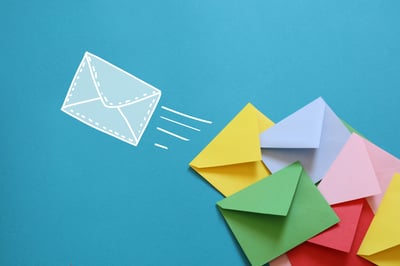October 8, 2021
 by Angela Ash / October 8, 2021
by Angela Ash / October 8, 2021

Marketers often wonder why their emails frequently get sent to spam.
Maybe you’ve even questioned why your email click-through rates (CTR) aren’t as high as you hoped. You might have high-quality, relevant content in your emails, perfect for your audience, with amazing graphics embedded in the email itself. Despite all of this, the “send-to-spam” culprit is more obvious than you’d think. We’re talking about your email subject lines.
For email campaigns to actually be successful, customers have to be swayed to open the email in the first place. And piquing a customer’s interest is more difficult than it seems.
People are bombarded with emails every day, and the mad scramble to reach "inbox zero" is on. So what can you do to make your emails stand out from the crowd? Craft an email subject line that is simply too good for readers to ignore.
Subject lines can literally make or break your email marketing campaign because they are the sole factor that determines the fate of your emails. Will it be read? Will it be immediately deleted? Will it be flagged as spam?
Marketers have struggled to provide a comprehensive guide to cast light to this complex subject, but the truth is that you’ll need to add a personal touch to your email campaigns and create a mix of subject lines for the correct intentions. But how do you do this while still being professional, innovative and exciting?
We've compiled some best practices for writing catchy email subject lines below. Because really – who doesn't want a higher CTR?
When it comes to stellar subject lines, the major conundrum is how to be professional, innovative, and exciting in one short line of text. Yet, these three traits absolutely must come across to the audience, or else your email marketing campaign won’t be as successful as it can be otherwise.
The easiest way to experiment along those lines is to decide on a style and stick to it. It goes without saying that you should know your audiences. Pick a style that will appeal to them. This is the very first step. Namely, what may work for one audience may be totally inefficient for another. Think in terms of demographics and shopping history.
For the most part, subject lines aim to create a target emotion (or more than one). Many marketers settle for creating urgency, but this is not necessarily always the best approach. While seasonal sales may be announced in this way, other promotions and offers simply need to be less over the top.
You can announce the offers via your social media pages and keep an eye on the comments. Feedback is, generally speaking, the best guidance you can get.
We love getting emails that seem tailored specifically to us. No matter what else you choose to do with your campaigns, never forget to include the recipient’s name (you’ll get this info from the subscription form) and refer to a recent activity.
The latter usually takes the form of following up. Think in terms of emails you have received from your trusted brands. Professional brands never forget to follow up on an action, whether it be feedback after a purchase or a shopping cart reminder. If the customer has stopped shopping midway, don’t forget to inquire about what went wrong.
Email subject lines announce the purpose of the email and make certain that the body text follows up accordingly.
Example subject line:
|
“John, we selected this JUST for YOU!” |
This subject line works for:
As mentioned above, creating a sense of urgency is a well-known marketing trick. It works rather well on the majority of people, but keep in mind that some people are simply immune to manipulation. If statistics are to be believed, these are in the minority so you should be on the safe side, but remember to cherish loyal customers. If you get negative feedback from them, make certain to customize upcoming emails accordingly.
This strategy may be effective, but it is also tricky. In fact, inexperienced marketers often overdo it, creating a subject line that is annoying rather than tempting. For illustrative purposes, recall the average ridiculous spam email you have received. For many people, it goes along those lines: make a payment to this account to help me flee my country and I will share my fortune with you. Hurry, there’s only two days left!
Even though this silly example is rather obvious in its intentions, it still follows the basic rule of creating a sense of urgency: it includes a due date.
Another way to achieve the same effect is to add “ends by x date”.
Example subject line:
|
“Only two days left to save” |
This subject line works for:
Thinking outside of the box is an invaluable skill no matter what you do. When it comes to email marketing, it is simply irreplaceable. Just think about BuzzFeed - their newsletters are famous far and wide and their subscribers, as a rule, can’t wait to see what they’ll come up with next.
The main factor contributing to this incredible level of success is their unique and unpredictable subject lines. Here are some ideas on how you can brainstorm this strategy.
Don’t be afraid to shock your audience. As long as it is in good taste, pretty much anything goes. Sometimes even bad taste sells. Simply put, controversy can be a powerful tool in marketing when used the right way. For one thing, it grabs attention, and since it does, you should make sure to get your message across efficiently.
The most common mistake marketers opting for controversy make is to brainstorm the subject line but don’t follow up properly in the text body. That failure is nowadays usually referred to as “clickbaits” so tread carefully.
Don’t test this strategy unless you are confident that you understand your audience’s tastes.
Another important factor here is perception. Brands selling clothes and in particular, lingerie are rather versed in this subject. If uncertain of how to go about this, you can use their successful campaigns as a reference.
Beauty is probably the most elusive ideal of all. In different cultures, different criteria apply. What may appear attractive in a woman to a man from China, a man from Norway, and a man from Egypt may be diametrically opposite to what is attractive to an American man.
The same criterion applies to all products. When deciding on a shocking subject line, you need to pay particular attention to your audience’s perception.
Emojis can sometimes help your campaign, but sometimes they can prove disastrous. Much depends on your audience’s age and also on the type of products you sell. E.g. the typical Rolex watch buyer is unlikely to appreciate emojis in subject lines, but things may be rather different for youngsters and hobbyists.
If you decide to use emojis, remember to use only those that will underline the emotion you’re trying to get across. If you’re combining emojis with controversy, you may want to consider less common options.
With the variety of emojis to choose from, the question of most popular emojis might be difficult, initially. Still, psychology may help. As a rule, people revere positive emotions, meaning that smileys, hearts, suns, gifts, food and beverages are usually a safe choice.
Marketing companies have spent lots of time analyzing the use of emojis across countries, industries, and occasions. The most popular emoji rankings are as follows:
Keep in mind that different devices and browsers display emojis differently. The infamous plain square we’ve all seen at least once is the thing you wish to avoid by all costs.
The easiest way to know if your emojis will be displayed properly is to send a test version of your message to yourself. Access the message from different devices (desktop, laptop, mobile devices), browsers and operating systems.
When you open the message in an email client, the emojis are displayed based on the client’s preferences. Different email clients may display emojis in a visually different way or not support them at all. Let’s take Gmail as an example. It styles emojis in a more designed way than the more generic versions of Yahoo! or Outlook.
When accessing your inbox from a web browser, the emojis are displayed based on the web browser’s specifics. Commonly used emojis are mostly generic, with slight differences in coloring rather than styling.
Finally, when accessing your inbox on a mobile device, the emojis are displayed based on the device’s specifics. Mobile devices commonly alter the style of the emojis to match the look of their brand.
In that sense, emojis are similar to fonts. If your email recipient doesn’t have the target font installed, a default version will be displayed instead. In the case of emojis, that translates into a generic square.
Lastly, creating a play on words is not only witty, but it also shows that you have poured your soul into your marketing campaign. Customers appreciate knowing they matter, so this effort won’t be overlooked.
Take your time coming up with the best ideas. After all, the more effort you invest, the better long-term results will be.
Example subject line:
|
“This sale’s so hot, it’s on 🔥” |
This subject line works by:
Generally speaking, emojis can be safely used in the following situations:
Emojis should not be used in the following situations:
Curiosity is one of the most powerful emotions when it comes to marketing, so creating curiosity is used and overused profusely, and not always to the best of effects.
This strategy works on certain occasions, but not by any means in all. Here are some examples when creating curiosity can be effective:
Other ideas may come to mind. Stick to your business promise and the style and test away.
Example subject line:
|
“Click for a free, proven SEO tip from some of the leading experts” |
This subject line works because:
People like free stuff and all marketers know that. That’s why all brands try to attract new customers by offering some goodies free of charge. The best part about this strategy is that it doesn’t have to cost you an arm and a leg. More often than not, brands offer either discounts or a free downloadable asset.
Incentives can be offered in many situations, and the most efficient ones include:
Example subject line:
|
“Stay with us! Enjoy 25% off your annual subscription if you rejoin today!” |
This subject line works because:
There are a couple of factors to consider when brainstorming subject lines. We have presented some impactful strategies that can be efficient when used the right way. All successful strategies take insights into account. Never forget the age and the taste of your audience and only then attempt to test new approaches.
Generally speaking, successful approaches take into account:
On the other hand, practices that are not successful include:
Finally, there's the matter of email frequency. It has been established that even the
most stellar email marketing campaigns can fall on deaf ears if they are pestering recipients.
Generally speaking, when deciding on the frequency of the emails, you should always keep in mind that your audience is probably also following other competitors. While sometimes timings will inevitably overlap (e.g., prior to the most popular holidays), you should still think about people’s time zones. Time the emails so that they will be on top of the recipients’ inbox.
People usually check emails once in the morning and once in the evening, so go by that rule unless you have performed in-depth research based on your previous practices.
As for the question how often to send emails, the simplest answer is: whenever you have new quality content to advertise. The key thing to remember here is that each and every email you send should provide value to your subscribers and customers.
Just what the form the value will take is up to you to decide. The trigger for sending an email can include either of the following:
Other ideas may also occur to you as you’re drafting both your email marketing calendar and your content calendar.
Every email marketing campaign should be unique just as every brand is unique. It is important to shape your style, tone, and business promise and to keep creating value no matter what you do.
Lastly, listen to customer feedback. Be proactive and ask for customers' opinions. After all, with cross-promotion abound, it’s never been easier to communicate with your audience. And every good marketer knows that communication is what drives success.
Angela Ash is a professional writer, editor, and digital PR specialist. She works with Flow SEO, a boutique SEO agency.
When it comes to email marketing, subject lines are an introduction to the offer that follows.
 by Angela Ash
by Angela Ash
Newsletters are a fast and efficient way to attract more followers and, ultimately, more...
 by Angela Ash
by Angela Ash
Writing a professional email blends writing style, etiquette, and the pressure of having to...
 by Rob Browne
by Rob Browne
When it comes to email marketing, subject lines are an introduction to the offer that follows.
 by Angela Ash
by Angela Ash
Newsletters are a fast and efficient way to attract more followers and, ultimately, more...
 by Angela Ash
by Angela Ash


